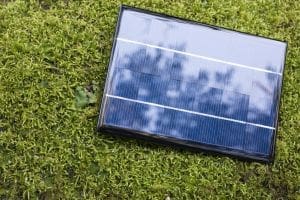
Today’s solar panels, which rely on silicon-based solar cell technology, are nearing their peak capacity to convert sunlight into electricity at a rate of 29%. However, significant advancements made by numerous research groups globally have propelled solar power cells beyond a crucial threshold, achieving energy efficiency of over 30%.
According to one expert, the feat makes this a “revolutionary” year and could accelerate the rollout of solar power.
Today’s solar panels are rapidly approaching their maximum conversion of sunlight to electricity of 29 percent using silicon-based cells. Simultaneously, scientists emphasize the necessity of a tenfold increase in the installation rate of solar power to address the climate crisis. The key breakthrough in achieving this objective involves the application of an additional semiconductor layer, namely perovskite, atop the existing silicon layer. This layer captures blue light from the visible spectrum, while silicon captures red light, boosting overall total light. By enhancing the energy absorption per cell, the cost of solar electricity further reduces, facilitating a faster deployment that contributes to mitigating global heating and its adverse effects.
Research into perovskite-silicon “tandem” cells has been going on for about a decade, but recent breakthroughs have seen them surpass the 30 percent milestone. If the production scaling of tandem cells progresses smoothly, experts believe they could become commercially available in approximately five years, coinciding with when silicon-only cells reach their peak efficiency. Currently, commercial silicon-only solar cells boast an efficiency record of 24.5 percent, while laboratory cells demonstrate an efficiency of 27 percent, approaching the theoretical maximum of 29 percent. However, a research group led by Steve Albrecht at the Helmholtz Center Berlin for Materials and Energy in Germany has recently disclosed information detailing their achievement of efficiencies up to 32.5 percent for silicon-perovskite cells. The other group from the Federal Institute of Technology in Lausanne, Switzerland, led by Dr. Xin Yu Chin, demonstrated a 31.25 percent efficiency rate, concluding that tandem cells had the “potential for both high efficiency and low manufacturing costs.”
“What these two groups have shown are really milestones,” said De Wolf. In June, his research group accomplished an efficiency of 33.7 percent using a tandem cell; however, the results have not yet been published in a journal. It is important to note that all efficiency measurements were independently validated.
“Overcoming the 30 percent threshold provides confidence that high-performance, low-cost PVs can be brought to the market,” said De Wolf. In 2022, the global solar power capacity reached an impressive milestone of 1.2 terawatts. Yet, according to De Wolf, “to avert the catastrophic scenarios associated with global warming, the total capacity needs to increase to about 75 TW by 2050.”
The solar industry is actively participating in the pursuit of high-efficiency solar cell technology. In June, LONGi, the largest producer of solar cells worldwide, revealed that they had achieved a significant milestone in their research by reaching an efficiency of 33.5 percent. “Reducing the cost of electricity remains the perpetual theme driving the development of the photovoltaic industry,” said Li Zhenguo, the president of LONGi.
“The industry is running very, very fast,” De Wolf said. “And I’m sure that multiple companies are working on this in China.” According to his statement, Europe and the United States must augment their research and development funding to keep pace and actively contribute to the rapid expansion of solar power deployment. So far, all high-efficiency tandem cells above 30 percent efficiency are small, measuring 1 cm by 1 cm. They need to scale up to the size of commercial cells, which are 15 cm squares.
The process of scaling up is already in progress, and UK-based company Oxford PV recently announced a remarkable achievement in May. They reported a record-breaking efficiency of 28.6 percent for a commercial-size solar cell. “Solar is already one of the least expensive and cleanest forms of energy available, and our technology will make it even more affordable,” said chief technology officer at Oxford PV, Chris Case.
The Oxford PV cell was manufactured using the same production line utilized for conventional silicon-only cells. This shared production capability significantly simplifies the large-scale manufacturing of tandem solar cell technology. De Wolf said that tandem cells may be more expensive than silicon-only cells, but the cells are only a tiny part of a solar panel’s cost.
De Wolf highlighted the significance that all the research groups employed distinct approaches to tackle the issue, offering a broader range of options in the quest for optimal commercial design. “There’s still lots of room to go further,” he said. “I believe that the practical limit is well beyond 35 percent.”
See how the latest innovations in solar technology are being used to improve SolarRoyal products with the latest upgrades to our flagship SR1800 Solar Attic Ventilation Fan.
